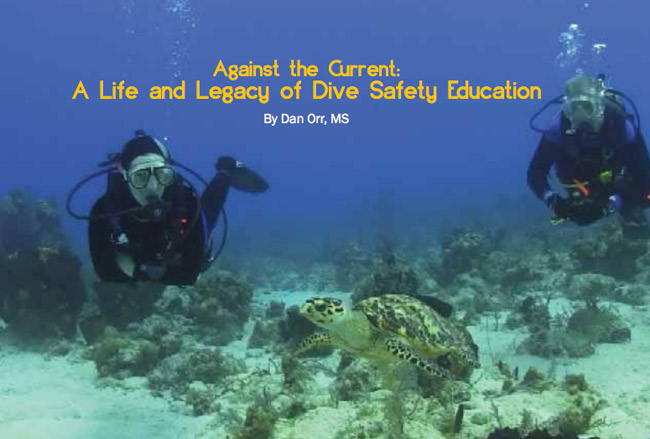Dan Orr is known as a first-class educator and longtime ambassador for the diving industry. After serving with Divers Alert Network for over two decades, Orr has announced his retirement in August of 2013. We caught up with him and asked him to share his philosophies on how to be a better teacher and better diver, all while setting the standard for safety that has persisted in the industry to this day.
I had the good fortune to grow up as a diver as the fledgling sport was also growing up. I can remember being involved in many pro and con discussions when new innovations came along. Lengthy and very animated discussions about whether or not to start using single hose regulators, buoyancy vests, power inflators for buoyancy devices, submersible pressure gauges, dive computers, enriched air nitrox and many, many other innovations were hotly debated not that many years ago.
Most of those innovations we consider a standard part of diving today. These innovations vastly improved the safety and the experience of scuba diving but the debates themselves were, for me, just as important and significant in my evolution as a diving educator. These debates opened my eyes and mind to the fact that there was a difference between being a scuba instructor and being a diving educator.
To me, a diving educator was someone with scuba instructor credentials who treated every course they taught or were involved in as a learning experience and an opportunity to make the next course even better. That was the approach I always used. I analyzed every exercise, looking at each student’s response in order to find ways to constantly improve the teaching and learning experience. We (and I include my staff of experienced volunteers) analyzed each open water dive we made with students to make sure that the skills we taught in the pool fully prepared students to safely enjoy the open water experiences. There were constant discussions going on with our staff to see if we could find ways to improve our training.
Whenever we had an opportunity, we would practice and analyze skills to make sure the skills we were teaching were, indeed, the best and most effective. 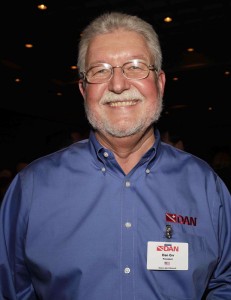 When we would attend meetings or conferences and hear about new techniques or equipment innovations, we would get our staff together and discuss and test them fully before incorporating them into our training. For example, when a debate over the use of CO2 cartridges in buoyancy devices was raging, there were a number of articles published for and against their use. These articles talked about divers being injured or killed by the accidental detonation of a CO2 cartridge at depth causing a rapid and uncontrolled ascent. Not taking anything at face value, I set out to test what I had read. I put together a practical research project where I actually detonated CO2 cartridges at a variety of depths recording the amount of time it took to make a noticeable change in my buoyancy. It clearly demonstrated that, with the exception of very shallow water, the amount of time it took to cause positive buoyancy was long enough to counteract the change in buoyancy by dumping the expanding gas out of the buoyancy device. Taking a serious look at this issue also helped us develop flaring techniques to further control a buoyant ascent. These flaring techniques would become extremely important with the advent of variable volume dry suits and ascent issues as a result of jettisoning weights in an emergency.
When we would attend meetings or conferences and hear about new techniques or equipment innovations, we would get our staff together and discuss and test them fully before incorporating them into our training. For example, when a debate over the use of CO2 cartridges in buoyancy devices was raging, there were a number of articles published for and against their use. These articles talked about divers being injured or killed by the accidental detonation of a CO2 cartridge at depth causing a rapid and uncontrolled ascent. Not taking anything at face value, I set out to test what I had read. I put together a practical research project where I actually detonated CO2 cartridges at a variety of depths recording the amount of time it took to make a noticeable change in my buoyancy. It clearly demonstrated that, with the exception of very shallow water, the amount of time it took to cause positive buoyancy was long enough to counteract the change in buoyancy by dumping the expanding gas out of the buoyancy device. Taking a serious look at this issue also helped us develop flaring techniques to further control a buoyant ascent. These flaring techniques would become extremely important with the advent of variable volume dry suits and ascent issues as a result of jettisoning weights in an emergency.
There were also articles published saying there was no need for the CO2 cartridge inflation option in an emergency because, in an out-of-air emergency, when you could no longer breathe through a regulator, there was still sufficient air in the scuba cylinder to inflate a buoyancy device at the surface using your power inflator. Once again, not willing to take anything at face value, my volunteer staff and I debated the issue and put together a way to test what was published. We tested a number of different regulators, buoyancy devices and power inflators breathing the air down to the point when either the pressure gauge was reading zero or you felt difficulty in breathing. We then recorded the time required to inflate the buoyancy device through power inflation. The results clearly demonstrated that this was a false premise. We used the same rationale to put every skill taught to divers to the test. We wanted to make sure that skills that worked well in the pool and during training could also used effectively and efficiently in the very real and highly variable open water environment. We tested and evaluated each and every skill in as many types of actual diving conditions as possible. And, of course, we discovered that some skills needed modification if the conditions were less than ideal. Once we saw that something needed to be modified, we worked to develop alternatives and then incorporated those changes into our teaching. At the same time, we reviewed every accident report we could get our hands on.
From 1970 until Divers Alert Network began collecting and publishing diver accident data, we would read the reports from the National Underwater Accident Data Center at the University of Rhode Island. These reports and the DAN data were invaluable in identifying the causes of diving accidents. Each time a report would come out, we’d devour each page extracting every bit of information and then finding ways to further modify our approach to teaching diving skills to give our students the tools with which to prevent accidents. I would also travel to dive sites sometimes just to sit and observe other divers looking for things that worked and things that didn’t.
Two important things came from this. One, I recognized that one problem that divers were having had to do with water in their masks. In talking with other diving instructors, it was clear that water in the mask was a major stressor that could possibly precipitate a diving accident. I, therefore, modified my skill training in the pool to have each student learn and practice each and every skill with and without a mask. We wanted to make sure that students would not rely on the mask when having to perform skills and were comfortable with water around their face even in simulated emergency skill training. Second, when observing divers at various dive locations, I saw how ‘creative’ divers can be with their equipment configuration. This was important to me because I could see new and possibly better ways of configuring equipment to make diving easier and/or safer.
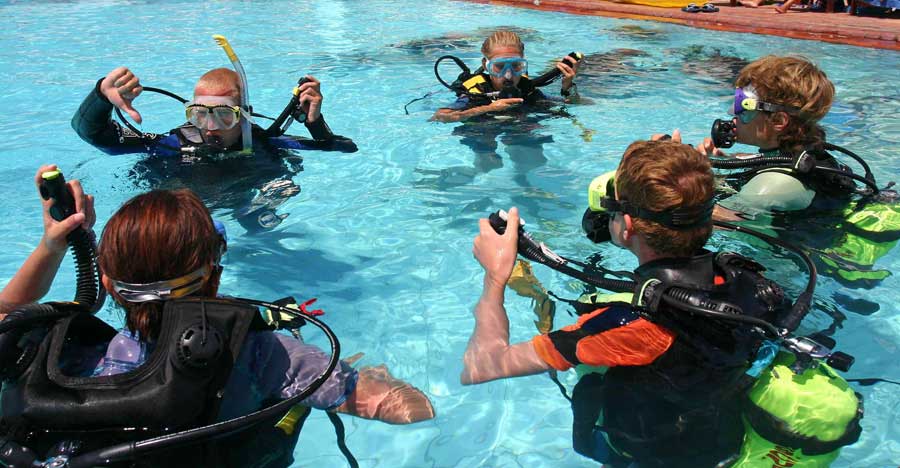
I modified my skill training in the pool to have each student learn and practice each and every skill with and without a mask.
I also saw things that made me shake my head in amazement. Cylinders in the backpack backwards with regulators upside down and backwards; divers in the open water having forgotten to put their regulators on the cylinders; and a number of other things that make you wonder just what these divers were thinking. These observations led me to create a presentation asking the question, “Are You REALLY Ready to Dive?” that I’ve presented all over the diving world to help divers understand the importance of proper equipment preparation and the value of working with your buddy as you prepare to dive to minimize the likelihood of equipment configuration errors. The importance of this aspect of preparation for diving was borne out by DAN’s review of nearly 1,000 diver fatalities where the majority of triggering event that turned an unremarkable dive into a tragedy were either directly or indirectly related to equipment use.
The more I learned about different ways of doing things, the more I wanted to share that information with others. I would regularly choose a subject that would help make diving safer or more enjoyable, I would create a presentation for the diving public. For example, I recognized the importance of comprehensive emergency assistance planning and created an emergency assistance plan (EAP) format that I not only taught to my students but presented to the nationwide diving community as well. These EAPs contained not only emergency contact information but were also site specific with detailed directions from each dive site to the nearest available medical facility. And, to make sure the information was correct, I would organize practice scenarios at each dive site we commonly used where we practiced a rescue that included all the appropriate diving first aid and removal of the ‘injured diver’ to the medical facility so we knew approximately how long it would take and that the route was correct. We tried to make sure that nothing was left to chance when someone’s wellbeing was at stake.
There were also presentations on the CO2 controversy, the use of nitrox, diver rescue and accident management, drugs and diving, hazardous environments (caves, wrecks and under ice), boat diving and diving injuries and fatalities. These are all very important topics when it comes to safety but one concern I had was that this information might imply that scuba diving was inherently unsafe and turn people away from the sport. Remember, in those early days, DAN had not come into existence and there was no diving emergency hotline.
I was fortunate to have gone to college at Wright State University (Dayton, Ohio), a branch campus of Ohio State and Miami Universities that eventually became an independent university. WSU was a progressive university in that it was accessible to everyone who wanted an education regardless of any physical limitations they might have. I don’t believe I ever had a class where there wasn’t a disabled person present. Therefore, I wasn’t surprised when a disabled student showed up in the very first scuba class I taught there. The problem was, there were no training standards or programs for certifying disabled students at the time. Early on, I developed the philosophy that “Our abilities should define us, not our limitations.” With every disability, we would find an accommodation without sacrificing safety for the diver or others they may dive with. There are few things more rewarding that seeing the expression on a diver’s face when they are free of their wheelchair or crutches for the first time and that they are just like everyone else, a diver. My staff and I spent a great deal of time developing accommodations and modifying skills to meet the needs of divers regardless of their ability. One thing we realized early on is that every person has limitations; our mantra became: Divers should be defined by their abilities, not their limitations. We were proud that there were many divers enjoying the sport then and now who may have otherwise been denied this experience.
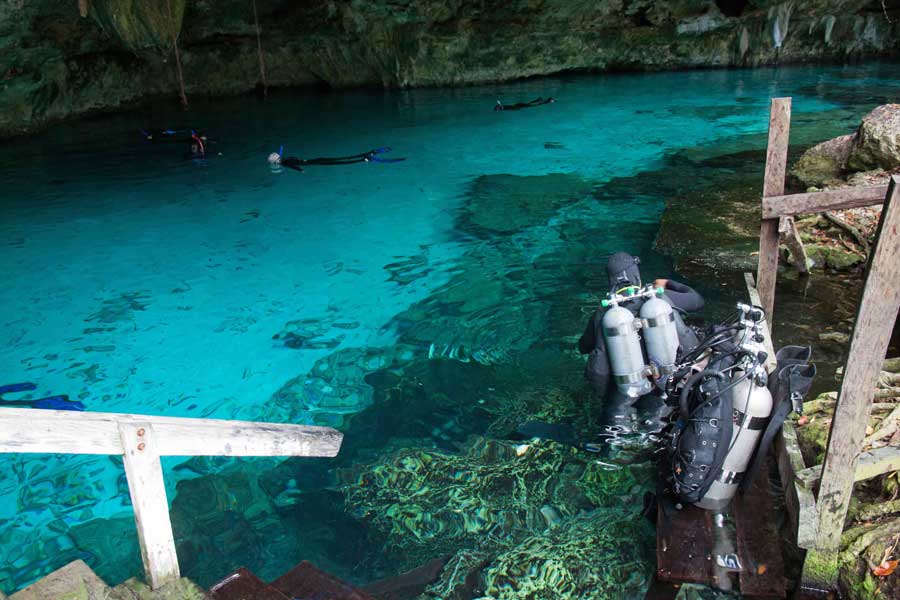
The percentage of divers not certified in cave diving who have died over the years has been steadily decreasing.
I reflected on the time I spent on the board of directors of the National Association for Cave Diving in the late 1980s. Non-cave divers and even some certified cave divers would approach me and ask about the detailed and sometimes gruesome accounts of cave diving fatalities published in the NACD magazine. They would say, “How can you wish to promote cave diving when you talk about those deaths in such detail?” My response would be, “We don’t promote cave diving, we promote SAFE cave diving.” When you look at the percentage of divers not certified in cave diving who have died over the years, that percentage has been steadily decreasing. The implication is that telling people about the risks in detail is a good tool to change behavior. The challenge is how to inform without terrifying. To be perfectly honest, the lessons I was trying to impart in my presentations could easily turn people off to the sport by listening to my material. So, I had to find a way to educate without terrifying. I chose to do that through the proper application of humor, kind of the ‘spoonful of sugar’ approach. Also, having been to lectures on almost every subject in diving and hyperbaric medicine, I reflected on those that I remembered and those that left a lasting impression on me. Each of those that were truly memorable had some humor so that I looked forward to the next slide rather than looking at my watch hoping that I would not have endure a second more.
I fully realized that to be a successful lecturer, you had to be part entertainer. An audience has certainly come to hear the material but humor opens the mind like very few other things and with an open mind, I believe, the audience will better understand and retain the information far longer. They will certainly be more inclined to attend another lecture in the future if they enjoyed themselves and learned at the same time. Admittedly, it is sometimes a challenge to come up with ways to illustrate a point about diver fatalities without seeming insensitive or silly. One thing I’ve done is to look at fatalities in the greater context. When saying that 90 divers die in diving-related accidents each year, I list other types of ways human beings terminate their existence. For example, over 100 people in Russia are killed by falling icicles each year, 130 people are killed by collisions with deer and 2,500 left handed people die using equipment designed for right handers. When I created a presentation addressing dive rescue, I wanted to make the point that there was no need for the rescuer to remove their mask to do mouth-to-mouth ventilations in the open water (as was suggested by a widely circulated paper on diver rescue). Therefore, I showed a rescuer performing ventilations with a variety of masks including one with Mickey Mouse ears. That spoonful of humor will certainly make the medicine of diver safety go down a lot easier and have lasting benefits.
All of this boils down to my basic philosophy of education. You must fully understand your subject and never take anything for granted when it comes to education or diver safety. When developing any curriculum, an outcome based approach is superior and help your audience with the strategic use of humor making them want to come back for more. One last thing. You have to honestly love what you do. Confucius was right when he said, “Choose a job you love, and you will never have to work a day in your life.” Although you may find that a job or career actually chooses you, taking a little time and effort to make whatever you do into something you love, certainly will reap benefits for you and all the people you meet.
——————————————————————————————————————————————————- 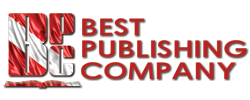 Reprinted with permission of the publisher. Best Publishing Company is the world’s foremost publisher of books on diving and hyperbaric medicine. For more information and resources, please visit the Best Publishing Company website www.BestPub.com. You can reach them at info@bestpub.com or (561) 776-6066. ——————————————————————————————————————————————————-
Reprinted with permission of the publisher. Best Publishing Company is the world’s foremost publisher of books on diving and hyperbaric medicine. For more information and resources, please visit the Best Publishing Company website www.BestPub.com. You can reach them at info@bestpub.com or (561) 776-6066. ——————————————————————————————————————————————————-

